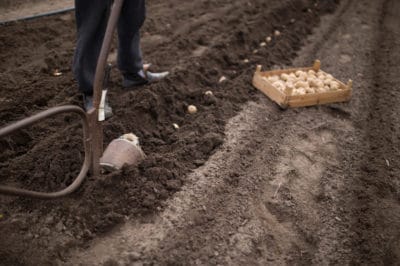Potato Growing Basics
The potato needs fertile, well-drained soil and should never be grown on the same ground twice. Amend your soil with lots of organic compost, well-rotted leaves or aged manure. Fresh manure may cause potato scab. Make sure the soil has consistent moisture; a drip system is an excellent way to water potatoes. Mulch is also helpful. Keep the weeds down to promote better growth.
Spring Planting
Many areas time potato planting around certain religious days. In cold climates, St. Patrick’s Day is often cited as a good choice. The real keys, however, are soil temperature, expected frosts and your ability to work the soil. Potatoes won’t grow until the soil temperature has reached 45°F (7°C). A hard frost can damage plants, so early planting carries risks. The soil must be light and friable, so you need to work it before planting – heavy spring rains can throw off the schedule.
Summer Planting
If you have a long growing season, you can plant potatoes up until about June 15th. Try to keep your potatoes in the ground as long as possible after a summer planting as it will give them time to reach full maturity. It also helps increase storage time and keeping qualities. Work and amend the soil prior to planting. Mulch to help conserve moisture.
Fall Planting
Gardeners in desert areas with very warm winters will usually do better with potatoes planted as a winter crop. Work the soil well and add amendments. Water or plant immediately after a rain. Mulching will keep moisture in the ground. It’s usually best to use early or mid-season varieties for fall planting, as they are more likely to mature before the spring weather turns hot. Some people in colder climates also plant in late fall; the plants won’t sprout until spring.
Choosing the Right Varieties
There are more than 4,000 known and/or named potato varieties, although most of these are found only in South America. Potatoes fall into several groups. The first is short-season or early potatoes that mature in 75 to 90 days. Mid-season potatoes mature in 90 to 110 days. Long-season varieties can take as much as 135 days to mature. Any of these can be harvested for “new” potatoes.
Choices for Short-Season Potatoes
All of these are readily available:
- Caribe – white flesh but purple skin. Will grow larger if left in the ground past 95 days and can be harvested later.
- Irish Cobbler – the classic russet-type baking potato.
- Norland – skin is a purplish-red, with white flesh
- Yukon Gold – yellow flesh, noted for flavor; tolerates close spacing.
Choices for Mid-Season Potatoes
These are good choices
- All Blue – unusual potato with purple flesh and dark purple skin.
- Carola – noted for flavor; yellow-fleshed.
- Kennebec – typical russet baking potato; stores well and has good flavor.
- Russet Burbank – similar to Kennebec.
- Yellow Finn – pale yellow interior, notable flavor.
Choices for Long-Season Potatoes
Many of these are heirloom varieties:
- Katahdin – a good baking potato with light brown skin, white interior. Virus-resistant.
- Bintje – the sprouts of this heirloom are purple, but the potatoes are yellow inside and out.
- German Butterball – another heirloom with waxy, yellow flesh and excellent flavor.
- Green Mountain – heirloom, not grown commercially because the tubers are irregular but has excellent flavor.
Potato Planting By Zone
Potatoes can be grown from USDA Zone 3 to Zone 10b if you choose the right varieties and plant at the right time. In the colder regions, you may not be able to plant until April or even May and should use early or mid-season varieties. In Zone 9, you can plant from January to March. In Zone 10 b, you should plant from September through March.
Potato Planting and Frost Dates
Whatever your climate or USDA Zone, frost dates are key to planting potatoes. A potato plant can handle a light frost, but a hard frost can freeze the vines to the ground. In some cases, the plants can recover and go on to make a crop. In spring, it’s best to plant two to three weeks before you expect the last frost. A hard frost in fall will kill plants completely, so time your planting for both maturity dates and expected frost dates.
